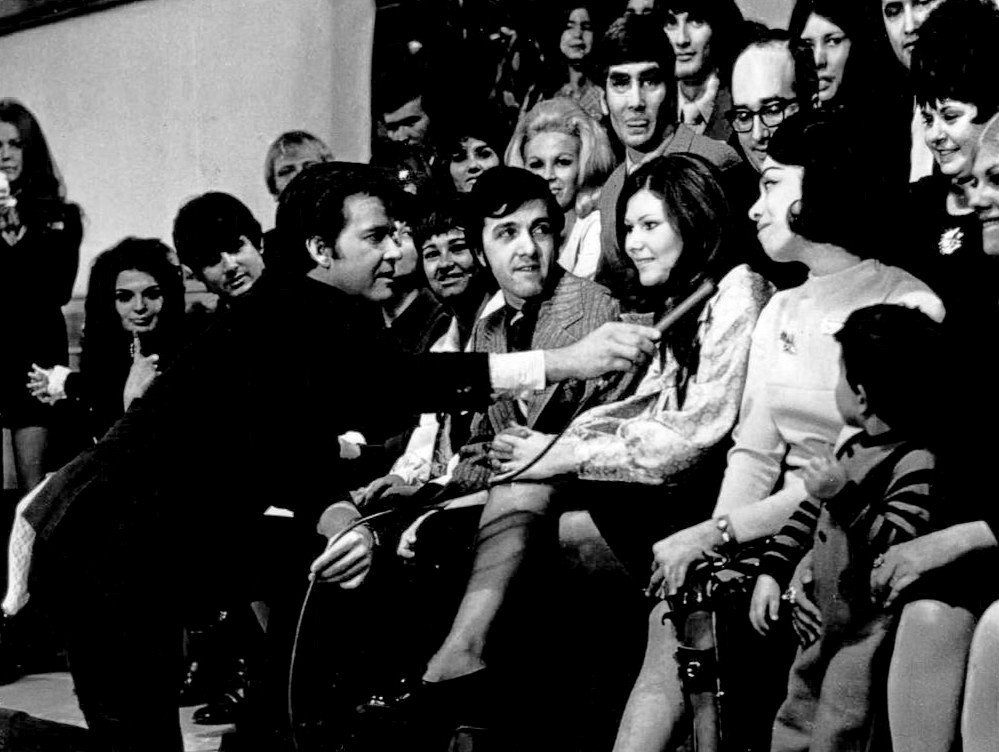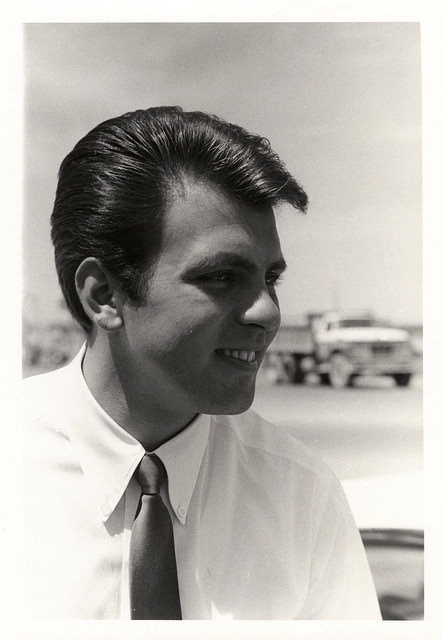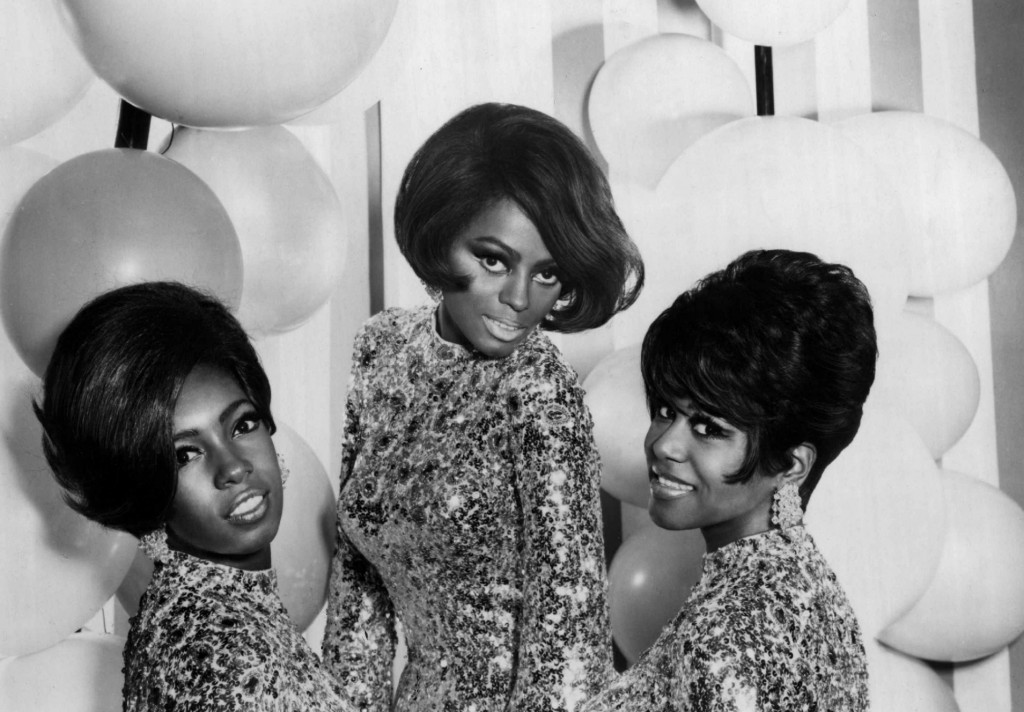6.3 The Reciprocal Nature of Music and Culture
Learning Objective
- Identify ways in which culture and music have influenced each other.
The tightknit relationship between music and culture is almost impossible to overstate. For example, policies on immigration, war, and the legal system can influence artists and the type of music they create and distribute. Music may then influence cultural perceptions about race, morality, and gender that can, in turn, influence the way people feel about those policies.
Cultural Influences on Music
The evolution of popular music in the United States in the 20th century was shaped by a myriad of cultural influences. Rapidly shifting demographics brought previously independent cultures into contact and also created new cultures and subcultures, and music evolved to reflect these changes. Among the most important cultural influences on music are migration, the evolution of youth culture, and racial integration.
Migration
One of the major cultural influences on the popular music industry over the past century is migration. In 1910, 89 percent of Black Americans still lived in the South, most of them in rural farming areas (Weingroff, 2011). Three years later, a series of disastrous events devastated the cotton industry. World cotton prices plummeted, a boll weevil beetle infestation destroyed large areas of crops, and in 1915, flooding destroyed many of the houses and crops of farmers along the Mississippi River. Already suffering from the restrictive “Jim Crow” laws that segregated schools, restaurants, hotels, and hospitals, Black sharecroppers began to look to the North for a more prosperous lifestyle. Northern states were enjoying an economic boom as a result of an increased demand for industrial goods because of the war in Europe. They were also in need of labor because the war had slowed the rate of foreign immigration to Northern cities. Between 1915 and 1920, as many as 1 million Black individuals moved to Northern cities in search of jobs, closely followed by another million throughout the following decade (Nebraska Studies, 2010). The mass exodus of Black farmers from the South became known as the Great Migration, and by 1960, 75 percent of all Black Americans lived in cities (Emerging Minds, 2005). The Great Migration had a huge impact on political, economic, and cultural life in the North, and popular music reflected this cultural change.
Some of the Black individuals who moved to Northern cities came from the Mississippi Delta, home of the blues. The most popular destination was Chicago. Delta-born pianist Eddie Boyd later told Living Blues magazine, “I thought of coming to Chicago where I could get away from some of that racism and where I would have an opportunity to, well, do something with my talent…. It wasn’t peaches and cream, man, but it was a hell of a lot better than down there where I was born (Szatmary).” At first, the migrants brought their style of country blues to the city. Characterized by the guitar and the harmonica, the Delta blues was identified by its rhythmic structure and strong vocals. Migrant musicians were heavily influenced by Delta blues musicians such as Charley Patton and legendary guitarist Robert Johnson. However, as the urban setting began to influence the migrants’ style, they started to record a hybrid of blues, vaudeville, and swing, including the boogie-woogie and rolling-bass piano. Mississippi-born guitarist Muddy Waters, who moved to Chicago in the early 1940s, revolutionized the blues by combining his Delta roots with an electric guitar and amplifier. He did so partly out of necessity, since he could barely make himself heard in crowded Chicago clubs with an acoustic guitar (Chicago Blues Guitar). Waters’s style was peppier and more buoyant than the sullen country blues. His plugged-in electric blues became the hallmark of the Chicago blues style, influencing countless other musicians and creating the underpinnings of rock and roll. Other migrant bluesmen helped to create regional variations of the blues all around the country, including John Lee Hooker in Detroit, Michigan, and T-Bone Walker in Los Angeles, California.
Youth Culture
Prior to 1945, most music was created with adults in mind, and teenage musical tastes were barely a consideration. Young adults had few freedoms—most males were expected to join the military or get a job to support their fledgling families, while most females were expected to marry young and have children. Few young adults attended college, and personal freedom was limited. Following World War II, this situation changed drastically. A booming economy helped create an American middle class, which created an opening for a youth consumer culture. Unsavory memories of the war discouraged some parents from forcing their children into the military, and many emphasized enjoying life and having a good time. As a result, teenagers found they had a lot more freedom. This new liberalized culture allowed teenagers to make decisions for themselves, and, for the first time, many had the financial means to do so. Whereas many adults enjoyed the traditional sounds of Tin Pan Alley, teens were beginning to listen to rhythm and blues songs played by radio disc jockeys such as Alan Freed. Increased racial integration within the younger generation made them more accepting of Black musicians and their music, which was considered “cool,” and provided a welcome escape from the daunting political and social tension caused by Cold War anxieties. The wide availability of radios, juke boxes, and 45 rpm records exposed this new style of rock and roll music to a broad teenage audience.
Figure 6.14
The popularity of American Bandstand made host Dick Clark an influential tastemaker in pop music.
Wikimedia Commons – public domain.
Once teenagers had the buying power to influence record sales, record companies began to notice. Between 1950 and 1959, record sales in the United States skyrocketed from $189 million to nearly $600 million (Szatmary). The 45 rpm vinyl records that were introduced in the late 1940s were an affordable option for teens with allowances. Dick Clark, a radio presenter in Philadelphia, soon tuned in to the new teenage tastes. Sensing an opportunity to tap in to a potentially lucrative market, he acquired enough advertising support to turn local hit music telecast Bandstand into a national television phenomenon.
Figure 6.15
Teen heartthrob Fabian was molded to fit teenage musical tastes in order to maximize record sales.
Otto Caldwell – Fabian Forte – CC BY-NC 2.0.
The result was the launch of American Bandstand in 1957, a music TV show that featured a group of teenagers dancing to current hit records. The show’s popularity prompted record producers to create a legion of rock and roll acts specifically designed to appeal to a teenage audience, including Fabian and Frankie Avalon (Grimes, 2011). During its almost 40-year run, American Bandstand was a prominent influence on teenage fashions and musical tastes and, in turn, reflected the contemporary youth culture.
Racial Integration
Following the Great Migration, racial tensions increased in Northern cities. Whereas many Northerners had previously been unconcerned with the issue of race relations in the South, they found themselves confronted with the very real issue of having to compete for jobs with Black migrant workers. Black workers found themselves pushed into undesirable neighborhoods, often living in crowded, unsanitary slums where they were charged exorbitant rates by unscrupulous landlords. During the 1940s, racial tensions boiled over into race riots, most notably in Detroit. The city’s 1943 riot caused the deaths of 34 people, 25 of whom were Black (Gilcrest, 1993).
Frustrated with inequalities in the legal system that distinguished Black and White individuals, members of the civil rights movement pushed for racial equality. In 1948, an executive order granted by President Harry Truman integrated the military. The move toward equality gained further momentum in 1954, with the U.S. Supreme Court decision to end segregation in public schools in the landmark case Brown v. Board of Education. The civil rights movement escalated throughout the late 1950s and early 1960s, aided by highly publicized events such as Rosa Parks’s refusal to give up her seat on a bus to a White passenger in Montgomery, Alabama, in 1955. In 1964, Congress passed the most sweeping civil rights legislation since the Civil War, forbidding discrimination in public places and authorizing financial aid to enable school desegregation.
Although racist attitudes did not change overnight, the cultural changes brought on by the civil rights movement laid the groundwork for the creation of an integrated society. The Motown sound developed by Berry Gordy Jr. in the 1960s both reflected and furthered this change. Gordy believed that by coaching talented but unpolished Black artists, he could make them acceptable to mainstream culture. He hired a professional to head an in-house finishing school, teaching his acts how to move gracefully, speak politely, and use proper posture (Michigan Rock and Roll Legends). Gordy’s commercial success with gospel-based pop acts such as the Supremes, the Temptations, the Four Tops, and Martha and the Vandellas reflected the extent of racial integration in the mainstream music industry. Gordy’s most successful act, the Supremes, achieved 12 No. 1 singles on the Billboard Hot 100 chart.
Figure 6.16
The commercial success of Motown girl group the Supremes reflected changing attitudes toward race in the United States.
Wikimedia Commons – public domain.
Musical Influences on Culture
Even though pop music is frequently characterized as a negative influence on society, particularly with respect to youth culture, it also has positive effects on culture. Many artists in the 1950s and 1960s pushed the boundaries of socially acceptable behavior with sexually charged movements and androgynous appearances. Without these precedents, acts like the Rolling Stones or David Bowie may have never made the transition into mainstream success.
On the other hand, over the past 50 years, critics have blamed rock and roll for juvenile delinquency, heavy metal for increased teenage aggression, and gangsta rap for a rise in gang warfare among young urban males. One recent study claimed that youths who listen to music with sexually explicit lyrics were more likely to have sex at an early age, stating that exposure to lots of sexually degrading music gives teens “a specific message about sex (MSNBC, 2006).” In addition to its effects on youth culture, popular music has contributed to shifting cultural values regarding race, morality, and gender.
Race
As the music of Chuck Berry and Little Richard gained popularity among White teens in the United States during the 1950s, most of the new rock acts were signed to independent labels, and larger companies such as RCA were losing their share of the market.
To capitalize on the public’s enthusiasm for rock and roll and to prevent the loss of further potential profits, big record companies signed White artists to cover the songs of Black artists. The songs were often censored for the mainstream market by the removal of any lyrics that referenced sex, alcohol, or drugs. Pat Boone was the most successful cover artist of the era, releasing songs originally sung by artists such as Fats Domino, the El Dorados, Little Richard, and Big Joe Turner. Releasing a cover of a Black performer’s song by a White performer was known as hijacking a hit, and this practice usually left black artists signed to independent labels broke. Because large companies such as RCA could widely promote and distribute their records—six of Boone’s recordings reached the No. 1 spot on the Billboard chart—their records frequently outsold the original versions. Many White artists and producers would also take writing credit for the songs they covered and would buy the rights to songs from Black writers without giving them royalties or songwriting credit. This practice fueled racism within the music industry. Independent record producer Danny Kessler of Okeh Records said, “The odds for a black record to crack through were slim. If the black record began to happen, the chances were that a white artist would cover—and the big stations would play the white records…. There was a color line, and it wasn’t easy to cross (Szatmary).”
Although cover artists profited from the work of Black R&B singers, occasionally they also helped to promote the original recordings. Many teenagers who heard covers on mainstream radio stations sought out the original artists’ versions, increasing sales and prompting Little Richard to refer to Pat Boone as “the man who made me a millionaire (Crane, 2005).” Benefiting from covers also worked both ways. In 1962, soul singer Ray Charles covered Don Gibson’s hit “I Just Can’t Stop Loving You,” which became a hit on country and western charts and furthered mainstream acceptance of Black musicians. Other Black artists to cover hits by White performers included Otis Redding, who performed the Rolling Stones hit “Satisfaction,” and Jimi Hendrix, who covered Bob Dylan’s “All Along the Watchtower.”
Hijacking Hits
Releasing cover versions of hit songs was fairly standard practice before the 1950s because it was advantageous for songwriters and producers to have as many artists as possible sing their records to maximize royalties. Several versions of the same song often appeared in the music charts at the same time. However, the practice acquired racial connotations during the 1950s when larger music labels hijacked R&B hits, using their financial strength to promote the cover version at the expense of the original recording, which often exploited Black talent. As a result, many 1950s R&B artists lost out on royalties.
Two contemporary Black performers who were victims of this practice were R&B singer LaVern Baker and blues singer Arthur “Big Boy” Crudup. Baker, who was signed with then small-time label Atlantic Records, had been promoted as a pop singer. Because her songs appealed to mainstream audiences, they were ideal for covering, and industry giant Mercury Records took full advantage of this. When Baker released her 1955 hit “Tweedle Dee,” Mercury immediately put out its own version, a note-for-note cover sung by White pop singer Georgia Gibbs. Atlantic could not match Mercury’s marketing budget, and Gibbs’s version outsold Baker’s recording, causing her to lose an estimated $15,000 in royalties (Parales, 1997).
Around the same time, Arthur Crudup was producing hits such as “So Glad You’re Mine,” “Who’s Been Foolin’ You,” “That’s All Right Mama,” and “My Baby Left Me,” which were subsequently released by performers such as Elvis Presley, Creedence Clearwater Revival, and Rod Stewart for huge financial gain, Crudup’s songs made everybody rich—except him. This realization caused him to quit playing altogether in the late 1950s. A later attempt to collect back royalties was unsuccessful (Stanton, 1998). Baker filed a lawsuit in an attempt to revise the Copyright Act of 1909, making it illegal to copy an arrangement verbatim without permission. The lawsuit was unsuccessful, and Gibbs continued to cover Baker’s songs (Dahl).
Morality
When Elvis Presley burst onto the rock and roll scene in the mid-1950s, many conservative parents of teenagers all over the United States were horrified. With his gyrating hips and sexually suggestive body movements, Presley was viewed as a threat to the moral well-being of young women. Television critics denounced his performances as vulgar, and on a 1956 appearance on the Ed Sullivan Show, cameras filmed him only from the waist up. One critic for the New York Daily News wrote that popular music “has reached its lowest depths in the ‘grunt and groin’ antics of one Elvis Presley (Collins, 2002).” Despite the critics’ opinions, Presley immediately gained a fan base among teenage audiences, particularly adolescent girls, who frequently broke into hysterics at his concerts. Rather than tone down his act, Presley defended his movements as manifestations of the music’s rhythm and beat and continued to gyrate on stage. Liberated from the constraints imposed by morality watchdogs, Presley set a precedent for future rock and roll performers and marked a major transition in popular culture.
In addition to decrying raunchy onstage performances by rock and roll artists, moralists in the conservative Eisenhower era objected to the sexually suggestive lyrics found in original rock and roll songs. Big Joe Turner’s version of “Shake, Rattle, and Roll” used sexual phrases and referred to the bedroom, while Little Richard’s original version of “Tutti Frutti” contained the phrase “tutti frutti, loose booty (Hall & Hall, 2006).” Although many of these lyrics were sanitized for mainstream White audiences when they were rereleased as cover versions, the idea that rock and roll was a threat to morality had been firmly implanted in many people’s minds.
Ironically, many of the controversial key figures in the rock and roll era came from extremely religious backgrounds. Presley was a member of the evangelical First Assembly of God Church, where he acquired his love of gospel music (History Of Rock). Similarly, Ray Charles soaked up gospel influences from his local Baptist church (Walk Of Fame). Jerry Lee Lewis came from a strict Christian background and often struggled to reconcile his religious beliefs with the moral implications of the music he created. During a recording session in 1957, Lewis argued with manager Sam Phillips that the hit song “Great Balls of Fire” was too “sinful” for him to record (History, 1957). The religious backgrounds of the rock and roll pioneers both influenced and challenged moral norms. When Ray Charles recorded “I Got a Woman” in 1955, he reworded the gospel tune “Jesus Is All the World to Me,” drawing criticism that the song was sacrilegious. Despite the objections, Charles’s style caught on with other musicians, and his experimentation with merging gospel and R&B resulted in the birth of soul music.
Gender
While Presley was revolutionizing people’s notions of sexual freedom and expression, other performers were changing cultural norms regarding gender identity. Dressed in flamboyant clothing with a pompadour hairstyle and makeup, Little Richard was an exotic, androgynous performer who blurred traditional gender boundaries and shocked 1950s audiences with his blatant campiness. Between his wild onstage antics, bisexual tendencies, and love of post-concert orgies, the self-proclaimed “King and Queen of Rock and Roll” challenged many social conventions of the time (Buckley, 2003). Little Richard’s flamboyant, gender-bending appearance was so outrageous that it was not taken seriously during the 1950s—he was considered an entertainer whose androgynous look bore no relevance to the real world. However, Richard paved the way for future entertainers to shift cultural perceptions of gender. Later musicians such as David Bowie, Prince, and Boy George adopted his outrageous style, frequently appearing on stage wearing glittery costumes and heavy makeup. The popularity of these 1970s and 1980s pop idols, along with other gender-bending performers such as Annie Lennox and Michael Jackson, helped make androgyny more acceptable in mainstream society.
Figure 6.17
Gender-bending performers such as Little Richard, David Bowie, Boy George, and Prince helped to change social attitudes toward androgyny.
Wikimedia Commons – public domain; Wikimedia Commons – CC BY-SA 3.0; Wikimedia Commons – CC BY-SA 4.0; Wikimedia Commons – CC BY 2.0.
Key Takeaways
- The relationship between music and culture is reciprocal. Cultural influences on music include factors such as migration, youth culture, and racial integration. Musical influences on culture include factors such as racism within the music industry, content of particular genres of music that push conventional ideas of morality, and the physical appearance of individual performers.
- The mass migration of Southern Black individuals to urban areas during the early 20th century brought the blues to the North. Influenced by their new urban setting, migrant musicians incorporated new styles, including vaudeville and swing, into their music. Muddy Waters began playing electric guitar to make himself heard in the Chicago clubs and inadvertently created a new style known as Chicago blues.
- Young people in the 1950s had increased financial and personal freedom, giving them the power to influence record sales. Record companies began marketing rock and roll records specifically to teens, and the popularity of the new genre was enhanced by radio airplay and TV shows such as American Bandstand.
- The civil rights movement helped bring about desegregation in the 1950s. Although racial tensions persisted and race riots occurred in several Northern cities, racial integration gradually took place. The move toward integration was furthered and reflected by the Motown sound created by Berry Gordy Jr. Motown had crossover appeal among Black and White audiences, illustrated by the mainstream success of groups such as the Supremes.
- Large record companies fueled racism in the music industry by hijacking the hits of Black performers and releasing censored cover versions by White artists. The practice cost Black artists royalties. Although many performers were angered by the trend, some believed it helped popularize their original recordings.
- Rock and roll music was denounced for its negative impact on morality. Elvis Presley’s “vulgar” onstage gyrations outraged critics in the conservative Eisenhower era. Sexually suggestive song lyrics were also held responsible by many for a decline in moral values, although they were often censored cover versions.
- Gender-bending performers such as Little Richard, David Bowie, and Annie Lennox helped normalize androgyny in American culture.
Exercise
Choose a genre of popular music from the last century. Using the ideas in this section as a starting point, examine ways in which your chosen genre has influenced aspects of culture and ways in which cultural aspects have affected the genre’s development.
- Which factors have played the biggest roles? Are they interrelated?
References
Buckley, Peter. The Rough Guide to Rock (Rough Guides, 2003), 603–604.
Chicago Blues Guitar, “Chicago Blues Guitar Story,” ChicagoBluesGuitar.com, http://www.chicagobluesguitar.com.
Collins, Dan. “How Big Was the King?” CBS News, August 7, 2002, http://www.cbsnews.com/stories/2002/08/07/entertainment/main517851.shtml.
Crane, Dan. “Cover Me: Introducing the Instant Tribute,” New York Times, March 27, 2005, http://www.nytimes.com/2005/03/27/arts/music/27cran.html.
Dahl, Bill. “LaVern Baker,” allmusic, http://www.allmusic.com/artist/lavern-baker-p3619/biography.
Emerging Minds, “The Great Migration,” Emerging Minds, January 31, 2005, http://emergingminds.org/The-Great-Migration.html.
Gilcrest, Brenda J. “Detroit’s 1943 Race Riot, 50 Years Ago Today, Still Seems Too Near,” Detroit Free Press, June 20, 1993.
Grimes, William. “Bob Marcucci, 81, Backer of Fabian and Frankie Avalon,” New York Times, March 18, 2011, http://query.nytimes.com/gst/fullpage.html?res=9A01EEDA1E3EF93BA25750C0A9679D8B63.
Hall, Dennis and Susan G. Hall, American Icons: An Encyclopedia of the People, Places, and Things That Have Shaped Our Culture Volume 1 (Greenwood, 2006), 134.
History Of Rock, “Elvis Presley,” History-of-rock.com, http://www.history-of-rock.com/elvis_presley.htm.
History, “Jerry Lee Lewis Records ‘Great Balls of Fire’ in Memphis, Tennessee,” History.com: This Day in History: October 8, 1957, http://www.history.com/this-day-in-history/jerry-lee-lewis-records-quotgreat-balls-of-firequot-in-memphis-tennessee.
Martin, Elizabeth Anne. “Detroit and the Great Migration, 1916–1929,” Bentley Historical Library, University of Michigan, http://bentley.umich.edu/research/publications/migration/ch1.php.
Michigan Rock and Roll Legends, “Berry Gordy Jr.,” Michigan Rock and Roll Legends,” http://www.michiganrockandrolllegends.com/Default.aspx?name=BERRYGORDY.
MSNBC, Associated Press, “Dirty Song Lyrics Can Prompt Early Teen Sex,” MSNBC, August 7, 2006, http://www.msnbc.msn.com/id/14227775/.
Nebraska Studies, “Racial Tensions in Omaha: African American Migration” Nebraskastudies.org, June 25, 2010, http://www.nebraskastudies.org/0700/stories/0701_0131.html.
Parales, Jon. “LaVern Baker is Dead at 67; A Rhythm-and-Blues Veteran,” New York Times, March 12, 1997, http://www.nytimes.com/1997/03/12/arts/lavern-baker-is-dead-at-67-a-rhythm-and-blues-veteran.html.
Stanton, Scott. The Tombstone Tourist; Musicians (New York: Simon & Schuster, 1998), 67.
Szatmary, Rockin’ in Time, 26.
Szatmary, Rockin’ in Time, 4.
Szatmary, Rockin’ in Time, 57.
Walk Of Fame, “Ray Charles,” Hollywood Walk of Fame, http://www.walkoffame.com/ray-charles.
Weingroff, Richard. “Highway History: The Road to Civil Rights: The Black Migration,” U.S. Department of Transportation Federal Highway Administration, April 7, 2011, http://www.fhwa.dot.gov/highwayhistory/road/s10.cfm.






